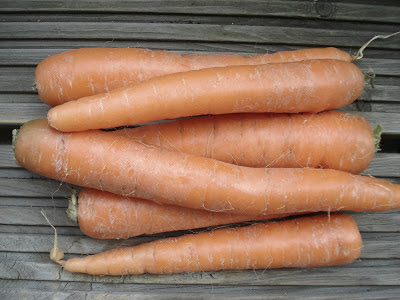The End is Nigh!
Oh August! Where have you gone? You flew by like a whirlwind, and left a blaze in our midst... With September lurking around the corner, I am feeling a chill down my spine. Next thing you know, Autumn will be at our doorsteps.
I don't know about you, but I hardly had time to see August whizz by. What with my skewed work schedule, I barely know what day it is, so it felt like I got sucker-punched when I realised August was coming to an end. Were it not for the fact that I saw little kids and young adults all dressed up for school, I probably would not have noticed that summer was creeping towards its curtain call until it was too late! This, despite the fact that nights are now comfortable enough to sleep under fluffy duvets (with the windows wide open!); that I have to scrounge through the tangled mess that are my tomato plants in order to harvest my daily pound or so before the squirrels get to them (they already finished off all the pumpkins... There will be no homegrown Hallowe'en display this year); that autumn vegetables are appearing in my CSA basket... I could have remained totally clueless...
So, September approaches with lumbering steps. What's in season? 'What's not in season?' should be the question!
If you've never stepped near a farmers' market, now is the time to go! And you better be feeling industrious, because you will heading home weighed down by a ridiculously large amount of food. This is the time of the year when just about everyone within the vicinity heads to the market for the annual stocking up on everything summer. It almost feels like taking part in an agricultural fair or a rural sidewalk sale! Bushels of tomatoes (in Montreal) go for 8$ to 15$ depending on the variety and level of ripeness; bell peppers are priced at 8$ to 20$; I saw bushels of eggplants for 10$; green and yellow wax beans are 5$ the half-bushel; shelling beans cost 4$ the half-bushel, but can also be bought in 20lb bags; chilli peppers; onions; carrots; and on and on....
If you're not up to tackling bushels of vegetables, consider sharing the lot with a friend or neighbour, because this is one time when I would advise buying in large quantities. Just the prospect of stocking up on the taste of summer should be motivation enough to break out the canning jars and freezer baggies! Just make sure you have the room to store your hoard.
I've mentioned shelling beans before, but I cannot emphasize enough how wonderful these beans are! They require some work, but if you have never shelled peas or beans before, you cannot possibly understand how ecstatically meditative the act of shelling can be when you've had a hectic day. I enter my own personal bubble when I start shelling legumes. Fresh shelling beans can be used like any old dry bean in salads; Succotash; or soups. But they differ from dry beans by not being gas-inducing. And they do not require any overnight soaking; just boil in a pot of salted water, or use for baked beans.
Each region will have their favourite shelling bean, so I cannot say what you will find where you live. In Montreal, Roma or Romana beans are most common. They are pretty unassuming at the green stage, but when they start drying, they take on psychedelic streaks that are repeated in the beans themselves. If you live in an area with a large African, Indian or Tamil community, you might be able to find hyacinth beans. These gorgeous beans are entirely edible from the moment they sprout from the ground (certain communities eat the shoots, while others eat the flowers, the fresh beans, freshly shelled beans or dry beans). If you cannot find these lookers, you can always grow them yourself: the seeds are sold just about anywhere as an ornamental.
I've only just noticed that, while I mention leeks quite often, I have yet to devote an entire post to this versatile vegetable. I will have to correct this shortly. Leeks have been making an appearance since late June, but September is when the fat spears make it t market. Though leeks of any size are magnificent vegetables, the larger ones tend to keep better. In any case, leeks, like their close cousin the green onion, should be kept in the refrigerator. Any other onion, including garlic, should be kept as far away as possible from the cold-box.
Garlic
Local heads of garlic have been trickling in for a while now, however now is the time to stock up for the winter: the bulbs are large and plump, and they have that papery-white skin that will protect them from drying out. The bulk of garlic productions hit the stands in September, and unless yo live in California or China, run, do not walk, to get your stash. In Quebec and Ontario -and I am assuming in most other Canadian provinces- the local garlic disappear by late October. You might be wondering why you should bother buying garlic that costs nearly double the price of imports. Well, aside from the obvious reasons I could give you, your local garlic is very much likely to be organic, even if it does not have a label or sticker that says it is so. Garlic is a relatively pest-free crop; requires little fertilization; and farmers will refrain from spraying if they don't have to. Imported garlic requires some spraying to make it through the commute. Also, given the proper conditions, local garlic will keep for an incredibly long time: I usually manage to save a few cloves well into April or May. The ideal place to keep garlic is in a cool, yet dry spot; in my case, that turned out to be the cupboard beneath my sink. Never store garlic in the fridge.
Potatoes, Onions, Cabbages and Co.
You can still get your hands on dirt-covered new potatoes, but storage potatoes are taking up more space on market stands. That means that the perfect potato for home-made fries and mash potatoes are going to abound shortly! Most root vegetables making it to market will be increasing in size, as they are easier to store. So you will have to eat your fill of baby roots before they disappear for the year.
Thick-skinned new onions can be lovely, but they do make one cry when it comes time to slice them; storage onions tend to be slightly less tear-inducing, and they have the advantage of keeping well under the sink, with the garlic and potatoes.
Although I doubt there is truly a season for coleslaw, sauerkraut is definitely a fall or winter thing. I don't know how to make sauerkraut from scratch, but I do love eating it! All manners of cabbages seem to have had a lovely year, because everything I've seen at the market are enormous! Finding cauliflower for two will be an impossible feat, so I might just give up, and find people to share the cole-ossus with instead (I couldn't resist the pun!)
Get them from a professional forager, or go hunting yourself. If you have no prior experience in foraging, go with a guide. You do not want to risk your life for a bite of wild delight... In Montreal, you can try contacting Mycoboutique to find a guide.
One word of advice: wild mushrooms should always be consumed thoroughly cooked. No quick stir-fry for these fungi because even edible wild 'shrooms can harbour certain toxins that can only be destroyed by heat. Sauté in a fat of your choice until they are nicely caramelized, and then stew for for 5 to 10 minutes in a liquid (wine, beer, cream, water or stock).
One word of advice: wild mushrooms should always be consumed thoroughly cooked. No quick stir-fry for these fungi because even edible wild 'shrooms can harbour certain toxins that can only be destroyed by heat. Sauté in a fat of your choice until they are nicely caramelized, and then stew for for 5 to 10 minutes in a liquid (wine, beer, cream, water or stock).
Winter Squash
Pumpkins; acorn squashes; butternut; buttercup; delicata; spaghetti; hubbard; pâtisson; potimarron; turban... They are all as lovely as their names imply.
I know, I understand that you are probably dreading the approach of autumn, but worry not, you can still hang on to the last vestiges of summer: there are still loads of melons; watermelons; peaches; plums (Ontarios yellow plums have, sadly, ended their season, but Quebec's Mont-Royals are in full swing); and nectarines to be had. I am readying myself for the stark season by making batches of peach and plum jams. If I still have storage space left, I might even tackle some strawberry and blueberry jams... Though autumn strawberries should carry on until October if there are no cold snaps in the forecast, stone fruits and melons will probably be gone by the end of the month, so stock up or gorge yourself, whichever is your prerogative.By the way, your eyes are not playing tricks on you: those watermelons are tiny!
Apples
The crisp, cool evenings are conducive to the production of crisp and crunchy apples. Need I say more? Call around or make a quick search on the internet for you-pick orchards in your area: I still harbour fond memories of picking apples on school outings.
Artichokes
I love artichokes. Last year I had to wait until October for Quebec artichokes, but with the summer we've had I would not be surprised to see them in September.
If you live in California or Greece, you might be just about tired of seeing figs... no, scrap that, one cannot possibly have too many figs! Figs are one of those godly foods that are, unfortunately, hard to find locally in most of Canada. Unless you live in British Colombia: I hear that there are healthy 'groves' of figs scattered about Vancouver Island. There might be a few figs trees in Southern Ontario, but for the rest of us, it'll have to be imports, or grow your own. Since I am not likely to be harvesting my own crop anytime soon, I just might have to give in... In the US, figs are hardy just about everywhere, except for New England.
Wild Pacific Salmon
The Sockeyes are running up river. And they say it's going to be record-breaking year... Let's cross our fingers and toes that the wild ones are truly making a comeback.
Bon app'!










Comments
Post a Comment